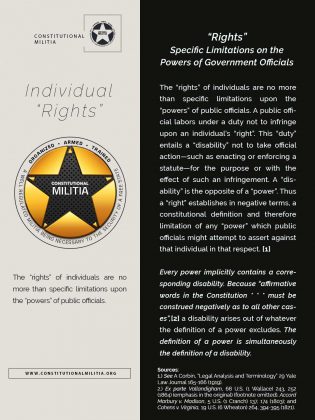Last Updated on January 16, 2023 by Constitutional Militia
2nd Amendment: “the Right”
The Second Amendment secures to each individual “the right to keep and bear Arms”, not just for his own benefit, but primarily for the benefit of everyone else. “[T]he right to keep and bear Arms”, translated through the duty “to keep and bear Arms”, emphasizes the obligation of each and every member of “the people”, not only to himself, but also to his community.
“The Right * * * to Keep and Bear Arms”: Constitutional Meaning
When they ratified the original Constitution and the Bill of Rights, WE THE PEOPLE knew—most of them from personal experience—that the substance of “the right * * * to keep and bear Arms” was to be found in America’s pre-constitutional Militia statutes in that pattern of behavior relative to firearms that had proven itself necessary for the formation and maintenance of “well regulated Militia” throughout this country’s history. In particular, the requirement that every adult able-bodied free White male (not a conscientious objector or otherwise specially exempted) should always maintain personal possession in his own home of at least one firearm and ammunition suitable for Militia service (“keep * * * Arms”), and be ready to bring that equipment into the field whenever called forth to duty (“bear Arms”).
In order to secure for themselves the permanent benefits of “the right * * * to keep and bear Arms” as Americans had always understood and applied it, THE PEOPLE knew that they had to render its meaning, as well as the meanings of “[a] well regulated Militia” and “a free State”, utterly independent of and immune from misconstruction and manipulation by anyone and everyone in public office in both the General Government and the governments of the several States as well—because “the right of the people to keep and bear Arms” (not any discretionary power of public officials) made “[a] well regulated Militia” possible, and therefore formed the foundation for “the security of a free State”. If “the right” were merely “a right” the substance of which Congress or the States’ legislatures determined, those bodies could never “infringe[ ]” it, because its very definition would depend entirely upon legislators’ discretion, or the prodding of factions and other private special-interest groups. And then even the meanings of “[a] well regulated Militia” and “a free State” could be transmogrified at the will of whomever happened to hold public office. To forefend this possibility, THE PEOPLE declared that “the right * * * shall not be infringed”, without any limitation as to whom that prohibition extended, or any allowance for purportedly special circumstances under which it might be deemed to be inoperative, or especially any license for anyone to redefine “the right” so that it could effectively be denied through verbal legerdemain. Thus, in one fell swoop, the Second Amendment preëmptively snatched from the rhetorical armamentarium of false judges the perverse modern doctrines of “reasonable regulation”, “compelling governmental interests” and “least-restrictive alternatives”, and “the living Constitution” where “the right * * * to keep and bear Arms” is concerned.
The so-called “individual-right” theory of the Second Amendment has gained a following among purported champions of the Amendment in modern times. Unfortunately, the height of its acceptance is inversely proportional to the depth of its insight into the true meaning of “the right of the people to keep and bear Arms”.
Both the Militia Clauses of the original Constitution and the Second Amendment guarantee not only a “collective right” of “the people” to participate in “well regulated Militia” as establishments within the federal system but also an “individual right” of each American among “the people” who compose or could compose the Militia to acquire and possess firearms suitable for Militia service, whether he actually trains and deploys in the field or not.
The Second Amendment is not merely redundant, because it explicitly highlights what is only implicit in the original Constitution: namely, that “[a] well regulated Militia” is “necessary to the security of a free State”—thereby making clear that “the Militia of the several States”, predicated upon “the right of the people to keep and bear Arms”, are indispensable structural components of America’s constitutional edifice.






























